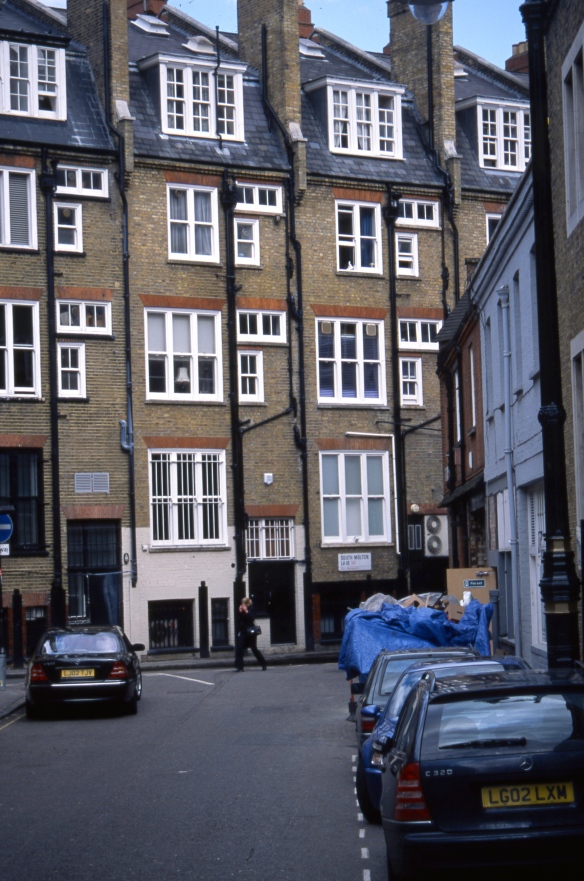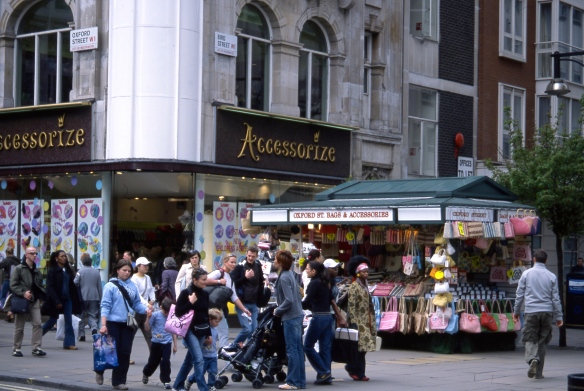Jackie spent the morning planting and clearing beds; I chipped in with dead-heading of roses. This afternoon we bought some trellis from Everton Nurseries to go round the decking. The return journey had me bent and contorted in the passenger seat with lengths of stapled wooden strips over my head. Fortunately it was only about five minutes.
I scanned another dozen of the Streets of London series of colour slides from April 2004.
Judy Dench was then starring in All’s Well That Ends Well at the Geilgud Theatre on the corner of Oxford Street and Rupert Street, W1. Some may consider her portrait less than enticing. The vehicles, the rooftops of which can be seen on Oxford Street were probably going nowhere fast.
The ubiquitous Starbucks, that purveyor of weak coffee – unless you pay for extra, tasteless, shots – has a presence in Avery Row. This was clearly an unusually warm April.
South Molton Lane lies to the West of New Bond Street,
where Roosevelt and Churchill continue their conversation first featured on 20th July. Most of us couldn’t afford the entrance fee for the shops behind them.
Seymour Mews is not far from Marble Arch. The grid of little square lights on the pavement outside Nordic Interiors is a common sight. These glass prisms, fitted to an iron cover, were introduced in the 1880s to throw light into the back of dingy coal cellars. Following the Clean Air Act, the coal has probably given way today to many other materials. The passing woman is probably quite ignorant of the fact that she is walking on private land.
The facades of the buildings in Albemarle Street are typical of Mayfair’s splendour. Probably every second of every day in London sees some maintenance or other being carried out. Here, it may have been street lighting that was being attended to. The typical jack-in-the-box adjustable platform suggests this to me.
Davies Mews is another of these frequently encountered little back streets that once held stables, and now house residents who can afford to pay millions for a tiny dwelling. These date from the 17th and 18th centuries. Built in rows behind large city houses, they consisted of a carriage house on the ground floor with residential accommodation above.
From Davies Street can be seen the mews mansard roofs, demonstrating how modern residents have enlarged their living space. What would those coachmen of earlier times think if they could see today’s conversions and rebuilds?
This was Oxford Street in April. Imagine it at the height of summer, especially during the Sales season. Moving against the milling flow of people and their buggies in this famous shopping street is a nightmare. At every junction, such as this one with Bird Street, there is a stall selling bags, T-shirts, trophies, nicknacks, fruit, hot-dogs, and much more.
Moving slightly North West we find Ranston Street, NW1. I don’t know if this was once a mews, but the rows of houses look very much like the typical rebuilds, where many, but not all, of the homes have retained a place for their modern, horseless, carriages on the ground floor. These workmen are attending to a roof, it seems.
Venables Street, NW8 runs into Church Street Market. It is therefore most appropriate that there should be a Tesco Metro. That is because Tesco was founded in 1919 by Jack Cohen as a group of market stalls. He had, himself, begun by selling surplus groceries from a stall in the East End of London. It would have been similar to those we see in Church Street today. The Tesco name first appeared in 1924, after Cohen purchased a shipment of tea from T. E. Stockwell and combined those initials with the first two letters of his surname. The first Tesco store opened in 1929 in Burnt Oak, Barnet.
This evening we dined on Jackie’s choice cottage pie, new potatoes, carrots, cauliflower, and ratatouille. The Cook drank Hoegaarden and I consumed more of the malbec










